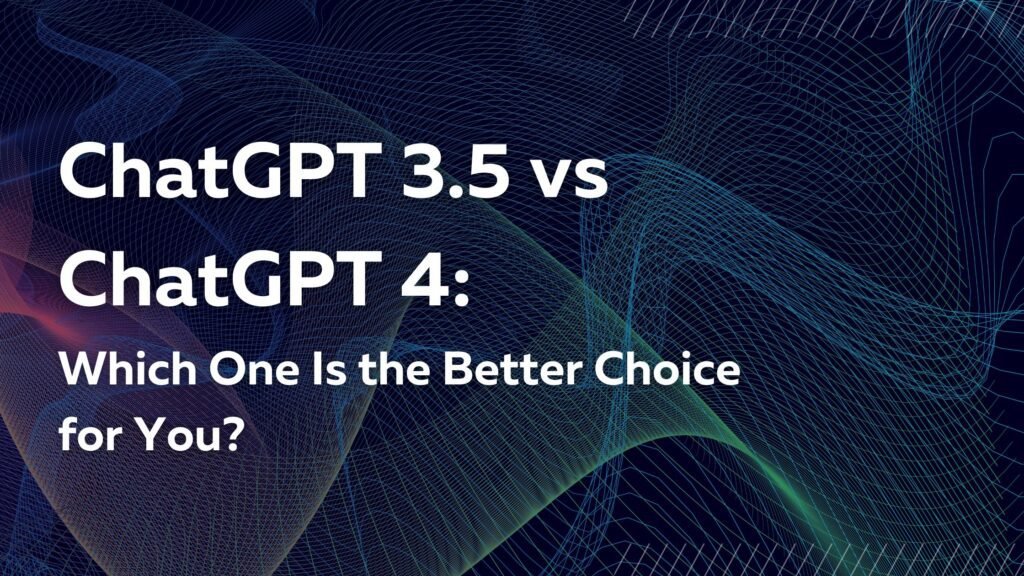The rapid advancements in artificial intelligence have given rise to powerful language models such as the battle between ChatGPT 3.5 vs ChatGPT 4, both developed by OpenAI. While both models have impressive capabilities, choosing between them can be challenging. In this comprehensive blog post, we will delve into the key features and differences between ChatGPT 3.5 and ChatGPT 4 to help you make an informed decision that best aligns with your needs and goals.
- Understanding the Underlying Technology
Before diving into their differences, it’s crucial to understand the technology behind these language models. Both ChatGPT 3.5 and ChatGPT 4 are built upon the same foundation, the GPT (Generative Pre-trained Transformer) architecture, which utilizes deep learning and natural language processing. This architecture allows the models to generate coherent and contextually accurate responses based on the input provided.
- Accuracy and Context Understanding
Both ChatGPT 3.5 and ChatGPT 4 excel in understanding context, but ChatGPT 4 takes it a step further. Its advanced architecture allows for a more profound understanding of context, providing responses that are increasingly accurate and coherent. If your project requires a deeper comprehension of context for more complex tasks, ChatGPT 4 is the preferred choice.
- Task-specific Performance
While ChatGPT 3.5 is a reliable and versatile language model that performs well in various applications, ChatGPT 4 demonstrates superior performance in specialized tasks. These include code generation, in-depth text analysis, and high-quality content creation. If you require exceptional performance in specific tasks, ChatGPT 4 is the ideal choice.
- Resource Efficiency
One of the most significant differences between ChatGPT 3.5 and ChatGPT 4 is their resource requirements. ChatGPT 4, with its enhanced capabilities, demands more computational resources. If you have limited resources or need a cost-effective solution without sacrificing performance, ChatGPT 3.5 is a more suitable option.
- Multilingual Support
Both ChatGPT 3.5 and ChatGPT 4 offer support for multiple languages. However, ChatGPT 4 improves upon this feature with its refined language understanding and translation capabilities. For projects that require seamless communication across several languages or accurate translation services, ChatGPT 4 is the superior choice.
- Adaptability and Customization
When it comes to adaptability and customization, ChatGPT 4 outshines ChatGPT 3.5. With its advanced architecture, it offers greater flexibility for users to fine-tune the model for specific applications. This makes ChatGPT 4 an attractive choice for businesses and individuals looking for a tailor-made solution catering to their unique needs.
- Continuous Learning and Improvement
Both ChatGPT 3.5 and ChatGPT 4 benefit from OpenAI’s continuous learning and improvement technology. However, due to its more advanced architecture, ChatGPT 4 is likely to experience more substantial improvements over time as more users interact with the model. If long-term improvement and growth potential are crucial factors for your project, ChatGPT 4 has the edge.
- User Experience and Accessibility
In terms of user experience and accessibility, both ChatGPT 3.5 and ChatGPT 4 offer intuitive interfaces, making it easy for users to leverage their capabilities. However, with its advanced features and performance, ChatGPT 4 may require a steeper learning curve for those new to AI-driven language models.
- Application Areas and Industry Use Cases
Both ChatGPT 3
Conclusion
In conclusion, both ChatGPT 3.5 and ChatGPT 4 offer impressive capabilities and valuable features. While ChatGPT 3.5 is an excellent choice for those with limited resources or seeking cost-effective solutions, ChatGPT 4 excels in task-specific performance, multilingual support, adaptability, and long-term improvement potential. By assessing your individual needs and project requirements, you can determine which model will best serve your goals and take advantage of the transformative power of AI-driven language models.

